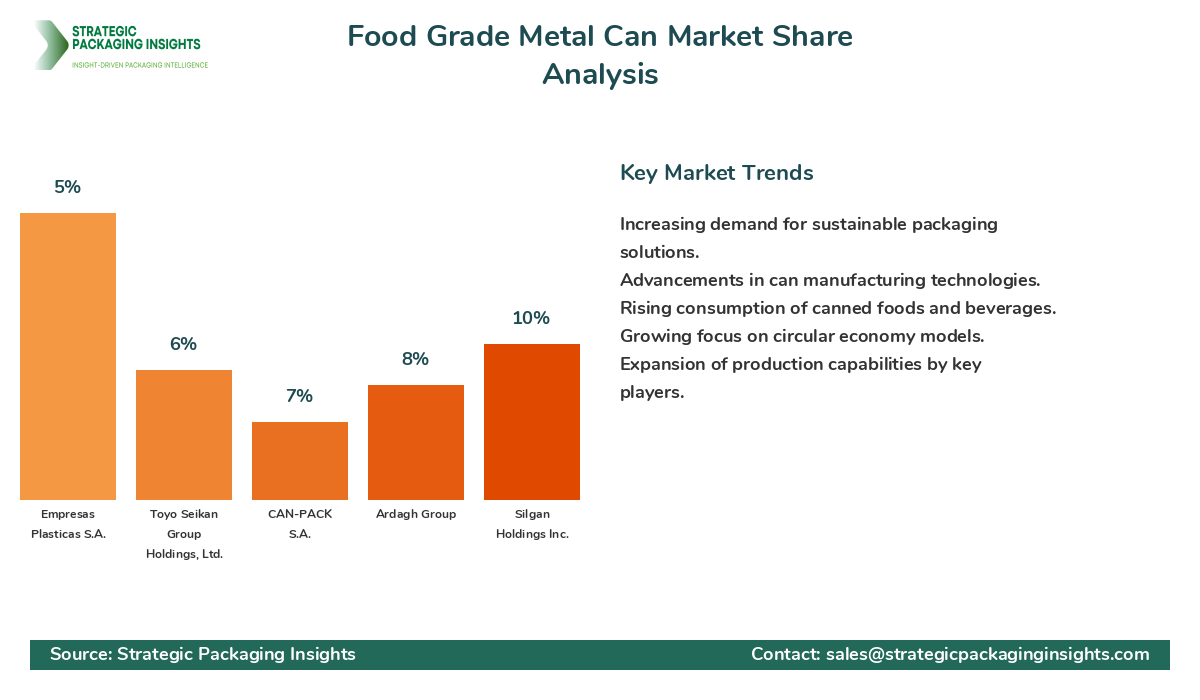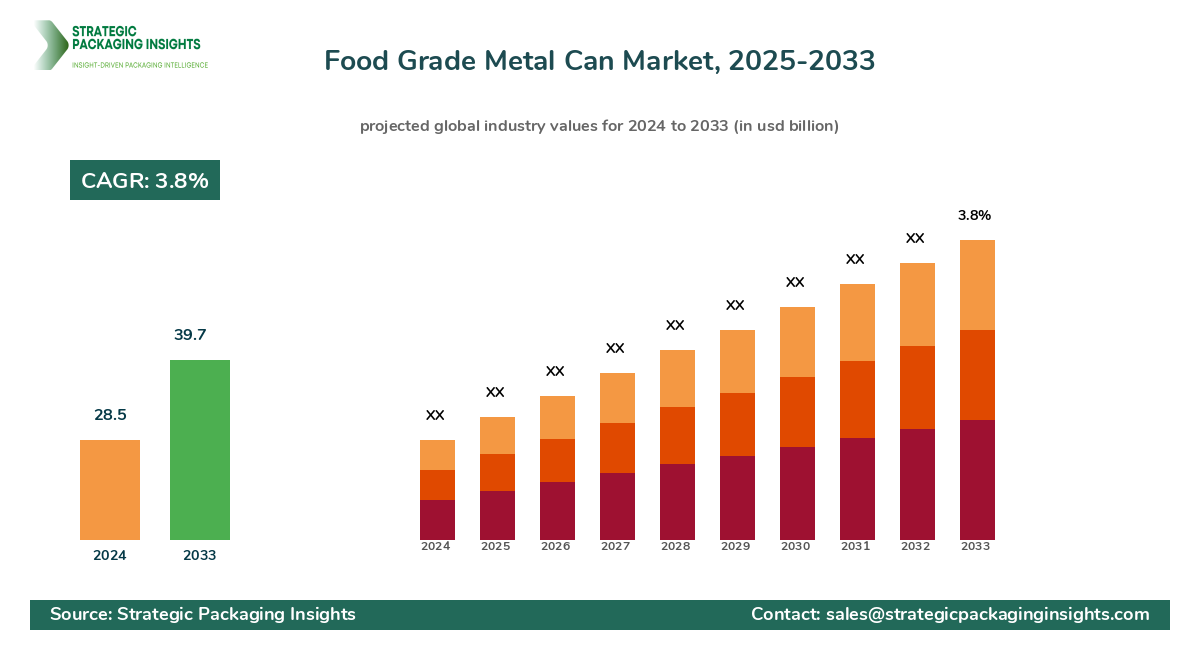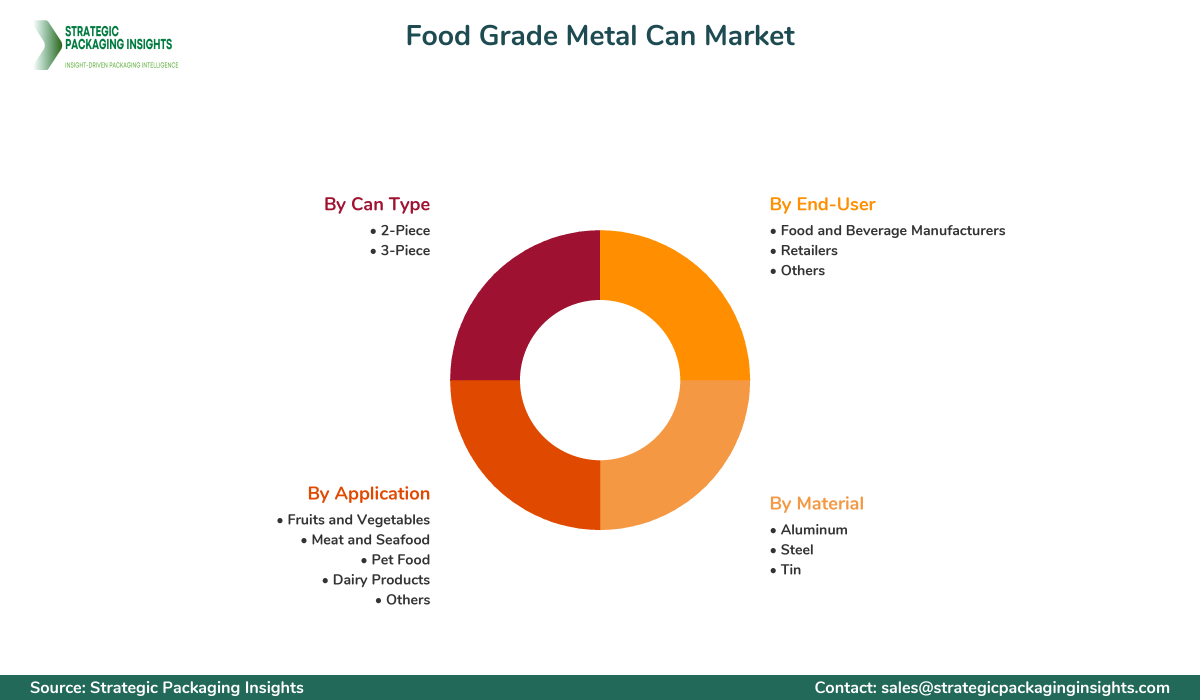- Home
- Food Packaging
- Food Grade Metal Can Market Size, Future Growth and Forecast 2033
Food Grade Metal Can Market Size, Future Growth and Forecast 2033
Food Grade Metal Can Market Segments - by Material (Aluminum, Steel, Tin), Application (Fruits and Vegetables, Meat and Seafood, Pet Food, Dairy Products, Others), Can Type (2-Piece, 3-Piece), and End-User (Food and Beverage Manufacturers, Retailers, Others) - Market Dynamics, Growth Opportunities, Strategic Drivers, and PESTLE Outlook (2025–2033)
Food Grade Metal Can Market Outlook
The food grade metal can market was valued at $28.5 billion in 2024 and is projected to reach $39.7 billion by 2033, growing at a CAGR of 3.8% during the forecast period 2025–2033. This market is driven by the increasing demand for sustainable and Recyclable Packaging solutions, as consumers and manufacturers alike are becoming more environmentally conscious. The durability and protective qualities of metal cans make them an ideal choice for preserving food quality and extending shelf life, which is crucial in reducing food waste. Additionally, the rise in urbanization and changing lifestyles have led to a higher consumption of canned foods, further propelling market growth.
However, the market faces challenges such as fluctuating raw material prices and the availability of alternative packaging solutions like plastics and glass. Despite these challenges, the market holds significant growth potential due to advancements in can manufacturing technologies and the increasing adoption of smart packaging solutions. Regulatory frameworks promoting the use of eco-friendly materials are also expected to drive market expansion. The potential for growth is particularly strong in emerging economies where the demand for packaged food is rising rapidly.
Report Scope
| Attributes | Details |
| Report Title | Food Grade Metal Can Market Size, Future Growth and Forecast 2033 |
| Base Year | 2024 |
| Historic Data | 2017-2023 |
| Forecast Period | 2025-2033 |
| Number of Pages | 238 |
| Material | Aluminum, Steel, Tin |
| Application | Fruits and Vegetables, Meat and Seafood, Pet Food, Dairy Products, Others |
| Can Type | 2-Piece, 3-Piece |
| End-User | Food and Beverage Manufacturers, Retailers, Others |
| Customization Available | Yes* |
Opportunities & Threats
The food grade metal can market presents numerous opportunities, particularly in the realm of sustainability. As environmental concerns continue to rise, there is a growing demand for packaging solutions that are not only effective but also environmentally friendly. Metal cans, being 100% recyclable, offer a significant advantage over other packaging materials. This recyclability not only reduces the carbon footprint but also aligns with the circular economy model, which is gaining traction globally. Furthermore, innovations in can design and manufacturing processes are opening new avenues for customization and branding, allowing companies to differentiate their products in a crowded marketplace.
Another opportunity lies in the expanding market for canned beverages and ready-to-eat meals. With the fast-paced lifestyle of modern consumers, there is an increasing preference for convenient and quick meal options. Metal cans provide a robust solution for preserving the freshness and taste of these products, making them a preferred choice for manufacturers. Additionally, the growing trend of premiumization in the food and beverage industry is driving the demand for high-quality packaging solutions, further boosting the market for food grade metal cans.
Despite these opportunities, the market is not without its threats. One of the primary challenges is the volatility in raw material prices, particularly aluminum and steel, which can significantly impact production costs. Moreover, the competition from alternative packaging materials such as plastics and glass poses a threat to the market. These materials often offer cost advantages and flexibility in design, which can be appealing to manufacturers. Additionally, stringent regulations regarding food safety and packaging standards can pose compliance challenges for manufacturers, potentially hindering market growth.
The food grade metal can market is characterized by a competitive landscape with several key players vying for market share. Companies such as Ball Corporation, Crown Holdings, Inc., and Silgan Holdings Inc. are among the leading players in this market, each holding a significant share due to their extensive product portfolios and strong distribution networks. These companies have been focusing on strategic initiatives such as mergers and acquisitions, product innovations, and expansions to strengthen their market position and enhance their product offerings.
Ball Corporation, for instance, is a prominent player known for its innovative packaging solutions and commitment to sustainability. The company has been actively investing in research and development to introduce new products that cater to the evolving needs of consumers and manufacturers. Similarly, Crown Holdings, Inc. has been focusing on expanding its global footprint through strategic acquisitions and partnerships, enabling it to tap into new markets and enhance its competitive edge.
Silgan Holdings Inc. is another major player in the food grade metal can market, known for its comprehensive range of packaging solutions and strong customer relationships. The company has been leveraging its technological expertise to develop advanced packaging solutions that meet the highest standards of quality and safety. Other notable players in the market include Ardagh Group, CAN-PACK S.A., and Toyo Seikan Group Holdings, Ltd., each contributing to the market's growth through their innovative products and strategic initiatives.
Ardagh Group, for example, has been focusing on sustainability and innovation to drive growth in the food grade metal can market. The company has been investing in new technologies and processes to enhance the recyclability and performance of its products. CAN-PACK S.A., on the other hand, has been expanding its production capabilities and strengthening its distribution network to cater to the growing demand for metal cans. Toyo Seikan Group Holdings, Ltd. has been leveraging its extensive experience and expertise in the packaging industry to develop innovative solutions that meet the diverse needs of its customers.
Key Highlights Food Grade Metal Can Market
- The market is projected to grow at a CAGR of 3.8% from 2025 to 2033.
- Increasing demand for sustainable and recyclable packaging solutions is driving market growth.
- Advancements in can manufacturing technologies are opening new avenues for market expansion.
- Emerging economies present significant growth opportunities due to rising demand for packaged food.
- Fluctuating raw material prices pose a challenge to market growth.
- Regulatory frameworks promoting eco-friendly materials are expected to drive market expansion.
- Competition from alternative packaging materials such as plastics and glass is a key threat.
- Innovations in can design and manufacturing processes are enhancing product differentiation.
- The market is characterized by a competitive landscape with several key players.
- Strategic initiatives such as mergers and acquisitions are helping companies strengthen their market position.
Top Countries Insights in Food Grade Metal Can
The United States is one of the leading markets for food grade metal cans, with a market size of $7.5 billion and a CAGR of 4%. The country's strong demand for packaged food and beverages, coupled with a well-established manufacturing sector, drives market growth. Additionally, the focus on sustainability and recycling initiatives further boosts the demand for metal cans.
China is another significant market, with a market size of $5.2 billion and a CAGR of 6%. The rapid urbanization and changing consumer preferences towards convenient and ready-to-eat meals are key growth drivers. The government's emphasis on sustainable packaging solutions also supports market expansion.
Germany, with a market size of $3.8 billion and a CAGR of 3%, is a prominent player in the European market. The country's strong focus on environmental sustainability and high standards for food safety drive the demand for food grade metal cans. The presence of leading packaging companies further enhances market growth.
India, with a market size of $2.9 billion and a CAGR of 7%, presents significant growth opportunities due to the rising demand for packaged food and beverages. The increasing disposable income and changing lifestyles of consumers are key factors driving market growth. Additionally, the government's initiatives to promote sustainable packaging solutions support market expansion.
Brazil, with a market size of $2.1 billion and a CAGR of 5%, is a key market in Latin America. The growing demand for canned food and beverages, coupled with the increasing focus on sustainability, drives market growth. The presence of a large consumer base and the expansion of the retail sector further boost market expansion.
Value Chain Profitability Analysis
The value chain of the food grade metal can market involves several key stakeholders, including raw material suppliers, manufacturers, distributors, and end-users. Each stage of the value chain plays a crucial role in determining the overall profitability and efficiency of the market. Raw material suppliers provide essential inputs such as aluminum and steel, which are critical for can production. The cost of these materials significantly impacts the pricing and profitability of the final product.
Manufacturers are responsible for converting raw materials into finished products through various processes such as cutting, shaping, and coating. The efficiency of these processes and the adoption of advanced technologies can enhance production efficiency and reduce costs, thereby improving profitability. Distributors play a vital role in ensuring the timely delivery of products to end-users, and their ability to manage logistics and supply chain operations can significantly impact market dynamics.
End-users, including food and beverage manufacturers and retailers, are the final link in the value chain. Their demand for high-quality and sustainable packaging solutions drives market growth. The profitability of each stakeholder in the value chain is influenced by factors such as production costs, pricing strategies, and market demand. Digital transformation is also reshaping the value chain by enabling greater efficiency and transparency, thereby redistributing revenue opportunities throughout the industry.
Evolving Market Dynamics (2018–2024) and Strategic Foresight (2025–2033)
The food grade metal can market has undergone significant changes between 2018 and 2024, driven by evolving consumer preferences and technological advancements. During this period, the market experienced steady growth, with a focus on sustainability and innovation. The adoption of advanced manufacturing technologies and the increasing demand for eco-friendly packaging solutions were key drivers of market expansion.
Looking ahead to the period from 2025 to 2033, the market is expected to continue its growth trajectory, driven by the rising demand for packaged food and beverages and the increasing focus on sustainability. The adoption of smart packaging solutions and the integration of digital technologies are expected to play a crucial role in shaping market dynamics. Additionally, the growing emphasis on circular economy models and the increasing demand for premium packaging solutions are expected to drive market growth.
During the forecast period, the market is expected to witness significant changes in segment distribution and regional contributions. The demand for aluminum cans is expected to increase due to their lightweight and recyclable nature. The Asia Pacific region is expected to emerge as a key growth driver, with countries such as China and India leading the way. The increasing focus on sustainability and the adoption of advanced manufacturing technologies are expected to drive market expansion in this region.
Food Grade Metal Can Market Segments Insights
Material Analysis
The material segment of the food grade metal can market is primarily divided into aluminum, steel, and tin. Aluminum cans are gaining popularity due to their lightweight and recyclable nature, making them an ideal choice for sustainable packaging solutions. The demand for aluminum cans is driven by the increasing focus on reducing carbon footprints and promoting circular economy models. Additionally, advancements in aluminum can manufacturing technologies are enhancing product quality and performance, further boosting market growth.
Steel cans, on the other hand, are known for their durability and protective qualities, making them suitable for preserving food quality and extending shelf life. The demand for steel cans is driven by the increasing consumption of canned foods and beverages, particularly in emerging economies. Tin Cans, although less common, are used for specific applications where corrosion resistance and product safety are critical. The demand for tin cans is driven by the need for high-quality packaging solutions that meet stringent food safety standards.
Application Analysis
The application segment of the food grade metal can market includes fruits and vegetables, meat and seafood, pet food, dairy products, and others. The demand for metal cans in the fruits and vegetables segment is driven by the need for preserving freshness and extending shelf life. Metal cans provide a robust solution for protecting the quality and taste of fruits and vegetables, making them a preferred choice for manufacturers.
In the meat and seafood segment, metal cans are used to preserve the freshness and taste of products, ensuring they remain safe for consumption. The demand for metal cans in this segment is driven by the increasing consumption of canned meat and seafood products, particularly in urban areas. The pet food segment is also witnessing significant growth, with metal cans being used to preserve the quality and taste of pet food products. The demand for metal cans in this segment is driven by the increasing adoption of pets and the growing demand for high-quality pet food products.
Can Type Analysis
The can type segment of the food grade metal can market is divided into 2-piece and 3-piece cans. 2-piece cans are gaining popularity due to their lightweight and cost-effective nature, making them an ideal choice for manufacturers looking to reduce production costs. The demand for 2-piece cans is driven by the increasing focus on sustainability and the need for efficient packaging solutions.
3-piece cans, on the other hand, are known for their durability and protective qualities, making them suitable for preserving food quality and extending shelf life. The demand for 3-piece cans is driven by the increasing consumption of canned foods and beverages, particularly in emerging economies. The adoption of advanced manufacturing technologies is enhancing the quality and performance of 3-piece cans, further boosting market growth.
End-User Analysis
The end-user segment of the food grade metal can market includes food and beverage manufacturers, retailers, and others. Food and beverage manufacturers are the primary end-users of metal cans, using them to preserve the quality and taste of their products. The demand for metal cans in this segment is driven by the increasing consumption of packaged food and beverages and the growing focus on sustainability.
Retailers also play a crucial role in the food grade metal can market, using metal cans to store and display products. The demand for metal cans in this segment is driven by the need for high-quality and durable packaging solutions that enhance product visibility and appeal. Other end-users include food service providers and institutional buyers, who use metal cans for various applications. The demand for metal cans in this segment is driven by the increasing focus on food safety and quality.
Food Grade Metal Can Market Segments
The Food Grade Metal Can market has been segmented on the basis of
Material
- Aluminum
- Steel
- Tin
Application
- Fruits and Vegetables
- Meat and Seafood
- Pet Food
- Dairy Products
- Others
Can Type
- 2-Piece
- 3-Piece
End-User
- Food and Beverage Manufacturers
- Retailers
- Others
Primary Interview Insights
What are the key drivers of growth in the food grade metal can market?
What challenges does the food grade metal can market face?
How are companies in the food grade metal can market addressing sustainability?
What opportunities exist for growth in the food grade metal can market?
What role does digital transformation play in the food grade metal can market?
Latest Reports

The corrugated board packaging market was valued at $250 billion in 2024 and is projected to reach $380 billion by 2033, growing at a CAGR of 4.5% during the forecast period 2025–2033.

The Water Soluble Packaging Films market was valued at $2.8 billion in 2024 and is projected to reach $5.6 billion by 2033, growing at a CAGR of 8.1% during the forecast period 2025–2033.

The Aluminium Foil Packaging market was valued at $25 billion in 2024 and is projected to reach $40 billion by 2033, growing at a CAGR of 5.5% during the forecast period 2025–2033.

The self-heating food packaging market was valued at $4.5 billion in 2024 and is projected to reach $7.8 billion by 2033, growing at a CAGR of 6.2% during the forecast period 2025–2033.

The Smart Container market was valued at $2.5 billion in 2024 and is projected to reach $8.7 billion by 2033, growing at a CAGR of 14.5% during the forecast period 2025–2033.

The Automatic Labeling Machine market was valued at $2.5 billion in 2024 and is projected to reach $4.8 billion by 2033, growing at a CAGR of 7.2% during the forecast period 2025–2033.

The Hot Melt Glue Labeler market was valued at $1.2 billion in 2024 and is projected to reach $2.3 billion by 2033, growing at a CAGR of 6.5% during the forecast period 2025–2033.

The Ethical Label market was valued at $1.5 billion in 2024 and is projected to reach $3.2 billion by 2033, growing at a CAGR of 8.5% during the forecast period 2025–2033.

The Packaging Tensioner market was valued at $1.2 billion in 2024 and is projected to reach $2.3 billion by 2033, growing at a CAGR of 6.5% during the forecast period 2025–2033.
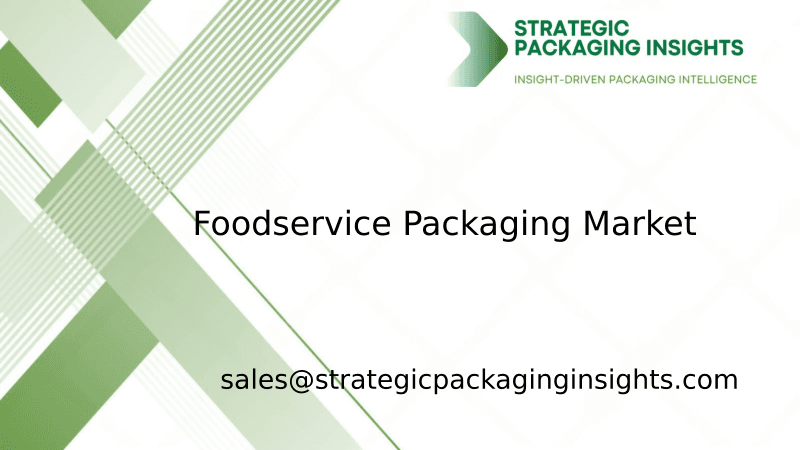
The foodservice packaging market was valued at $120 billion in 2024 and is projected to reach $180 billion by 2033, growing at a CAGR of 4.5% during the forecast period 2025–2033.

The nano-enabled packaging market was valued at $15.2 billion in 2024 and is projected to reach $35.6 billion by 2033, growing at a CAGR of 9.5% during the forecast period 2025–2033.

The Cold Seal Packaging market was valued at $1.5 billion in 2024 and is projected to reach $2.3 billion by 2033, growing at a CAGR of 4.8% during the forecast period 2025–2033.

The Transparent Barrier Packaging Films market was valued at $12.5 billion in 2024 and is projected to reach $20.3 billion by 2033, growing at a CAGR of 5.8% during the forecast period 2025–2033.

The Flatback Tape market was valued at $2.5 billion in 2024 and is projected to reach $4.1 billion by 2033, growing at a CAGR of 5.8% during the forecast period 2025–2033.

The packer bottle market was valued at $3.5 billion in 2024 and is projected to reach $5.8 billion by 2033, growing at a CAGR of 5.2% during the forecast period 2025–2033.
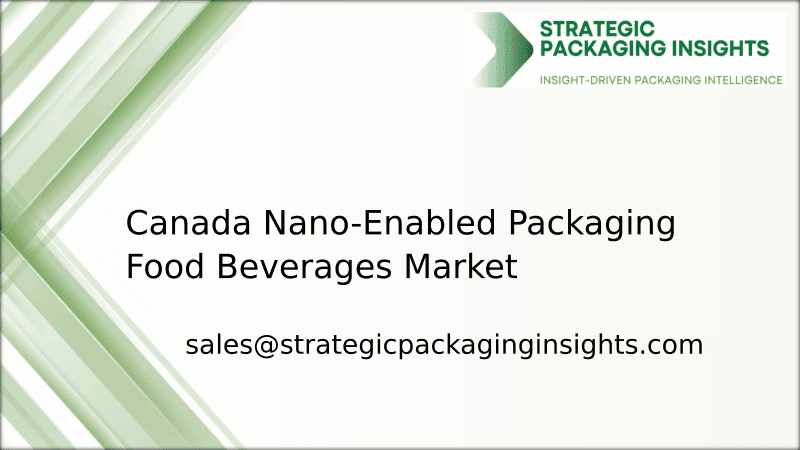
The Canada Nano-Enabled Packaging Food Beverages market was valued at $1.2 billion in 2024 and is projected to reach $3.5 billion by 2033, growing at a CAGR of 12.5% during the forecast period 2025–2033.
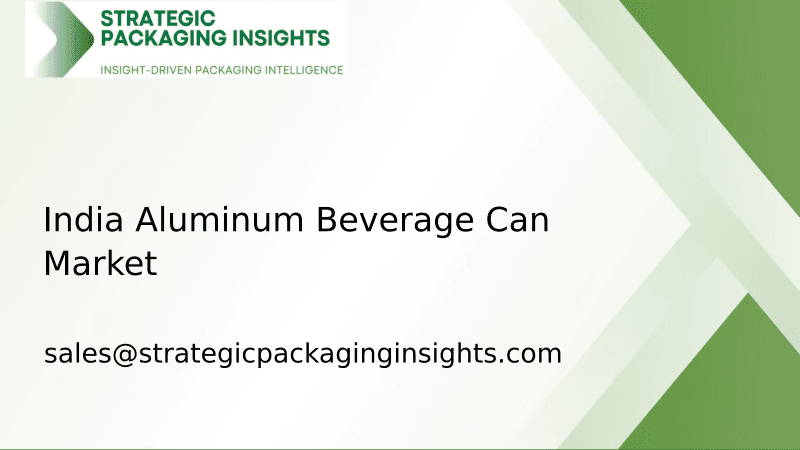
The India Aluminum Beverage Can market was valued at $1.2 billion in 2024 and is projected to reach $2.5 billion by 2033, growing at a CAGR of 8.5% during the forecast period 2025–2033.
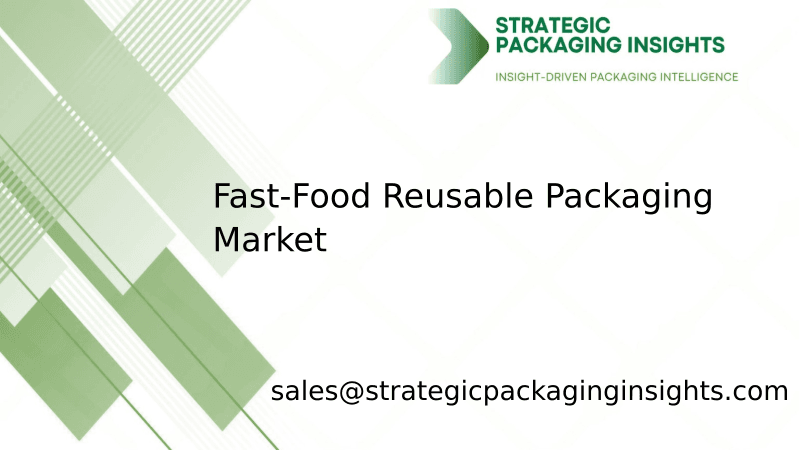
The fast-food reusable packaging market was valued at $1.2 billion in 2024 and is projected to reach $3.5 billion by 2033, growing at a CAGR of 12.5% during the forecast period 2025–2033.

The pallets market was valued at $59.91 billion in 2024 and is projected to reach $88.69 billion by 2033, growing at a CAGR of 4.5% during the forecast period 2025–2033.

The lamination adhesives market was valued at $2.5 billion in 2024 and is projected to reach $4.1 billion by 2033, growing at a CAGR of 5.8% during the forecast period 2025–2033.

The garment packing machine market was valued at $1.2 billion in 2024 and is projected to reach $2.5 billion by 2033, growing at a CAGR of 8.5% during the forecast period 2025–2033.
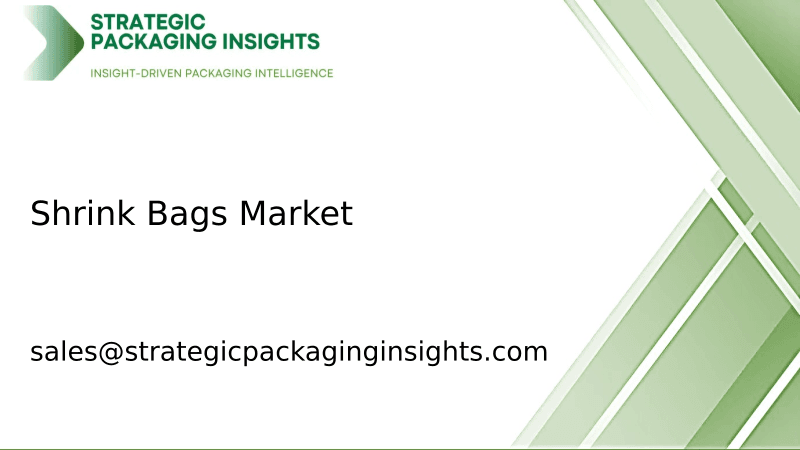
The shrink bags market was valued at $3.5 billion in 2024 and is projected to reach $5.8 billion by 2033, growing at a CAGR of 5.2% during the forecast period 2025–2033.

The beverage packaging market was valued at $128 billion in 2024 and is projected to reach $186 billion by 2033, growing at a CAGR of 4.2% during the forecast period 2025–2033.

The North America Freight and Logistics market was valued at $1,200 billion in 2024 and is projected to reach $1,800 billion by 2033, growing at a CAGR of 4.5% during the forecast period 2025–2033.

The Anti-Counterfeiting Packaging market was valued at $105 billion in 2024 and is projected to reach $182 billion by 2033, growing at a CAGR of 6.5% during the forecast period 2025–2033.

The corrugated board packaging market was valued at $250 billion in 2024 and is projected to reach $380 billion by 2033, growing at a CAGR of 4.5% during the forecast period 2025–2033.

The Water Soluble Packaging Films market was valued at $2.8 billion in 2024 and is projected to reach $5.6 billion by 2033, growing at a CAGR of 8.1% during the forecast period 2025–2033.

The Aluminium Foil Packaging market was valued at $25 billion in 2024 and is projected to reach $40 billion by 2033, growing at a CAGR of 5.5% during the forecast period 2025–2033.

The self-heating food packaging market was valued at $4.5 billion in 2024 and is projected to reach $7.8 billion by 2033, growing at a CAGR of 6.2% during the forecast period 2025–2033.

The Smart Container market was valued at $2.5 billion in 2024 and is projected to reach $8.7 billion by 2033, growing at a CAGR of 14.5% during the forecast period 2025–2033.

The Automatic Labeling Machine market was valued at $2.5 billion in 2024 and is projected to reach $4.8 billion by 2033, growing at a CAGR of 7.2% during the forecast period 2025–2033.

The Hot Melt Glue Labeler market was valued at $1.2 billion in 2024 and is projected to reach $2.3 billion by 2033, growing at a CAGR of 6.5% during the forecast period 2025–2033.

The Ethical Label market was valued at $1.5 billion in 2024 and is projected to reach $3.2 billion by 2033, growing at a CAGR of 8.5% during the forecast period 2025–2033.

The Packaging Tensioner market was valued at $1.2 billion in 2024 and is projected to reach $2.3 billion by 2033, growing at a CAGR of 6.5% during the forecast period 2025–2033.

The foodservice packaging market was valued at $120 billion in 2024 and is projected to reach $180 billion by 2033, growing at a CAGR of 4.5% during the forecast period 2025–2033.

The nano-enabled packaging market was valued at $15.2 billion in 2024 and is projected to reach $35.6 billion by 2033, growing at a CAGR of 9.5% during the forecast period 2025–2033.

The Cold Seal Packaging market was valued at $1.5 billion in 2024 and is projected to reach $2.3 billion by 2033, growing at a CAGR of 4.8% during the forecast period 2025–2033.

The Transparent Barrier Packaging Films market was valued at $12.5 billion in 2024 and is projected to reach $20.3 billion by 2033, growing at a CAGR of 5.8% during the forecast period 2025–2033.

The Flatback Tape market was valued at $2.5 billion in 2024 and is projected to reach $4.1 billion by 2033, growing at a CAGR of 5.8% during the forecast period 2025–2033.

The packer bottle market was valued at $3.5 billion in 2024 and is projected to reach $5.8 billion by 2033, growing at a CAGR of 5.2% during the forecast period 2025–2033.

The Canada Nano-Enabled Packaging Food Beverages market was valued at $1.2 billion in 2024 and is projected to reach $3.5 billion by 2033, growing at a CAGR of 12.5% during the forecast period 2025–2033.

The India Aluminum Beverage Can market was valued at $1.2 billion in 2024 and is projected to reach $2.5 billion by 2033, growing at a CAGR of 8.5% during the forecast period 2025–2033.

The fast-food reusable packaging market was valued at $1.2 billion in 2024 and is projected to reach $3.5 billion by 2033, growing at a CAGR of 12.5% during the forecast period 2025–2033.

The pallets market was valued at $59.91 billion in 2024 and is projected to reach $88.69 billion by 2033, growing at a CAGR of 4.5% during the forecast period 2025–2033.

The lamination adhesives market was valued at $2.5 billion in 2024 and is projected to reach $4.1 billion by 2033, growing at a CAGR of 5.8% during the forecast period 2025–2033.

The garment packing machine market was valued at $1.2 billion in 2024 and is projected to reach $2.5 billion by 2033, growing at a CAGR of 8.5% during the forecast period 2025–2033.

The shrink bags market was valued at $3.5 billion in 2024 and is projected to reach $5.8 billion by 2033, growing at a CAGR of 5.2% during the forecast period 2025–2033.

The beverage packaging market was valued at $128 billion in 2024 and is projected to reach $186 billion by 2033, growing at a CAGR of 4.2% during the forecast period 2025–2033.

The North America Freight and Logistics market was valued at $1,200 billion in 2024 and is projected to reach $1,800 billion by 2033, growing at a CAGR of 4.5% during the forecast period 2025–2033.

The Anti-Counterfeiting Packaging market was valued at $105 billion in 2024 and is projected to reach $182 billion by 2033, growing at a CAGR of 6.5% during the forecast period 2025–2033.
